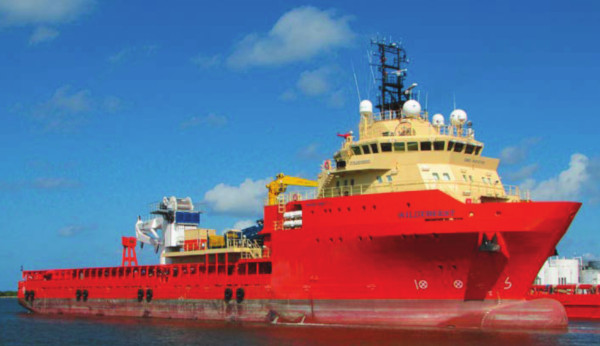
At the end of 2014, through our sister company, Lankhorst, we at CASAR received an interesting request to fit the ropes on a 40-ton AHC articulating crane of the Dutch manufacturer, Langendijk Equipment. The crane is installed on the supply ship Wildebeest, which serves oilrigs of the Edison Chouest Offshore company (ECO).
It lifts and lowers loads weighing up to 40 t, to a depth of up to 3,000 m. In consideration of the required safety factor 5, the rope has to have a minimum breaking force of 200 tons. The wires used to produce the CASAR Eurolift have a nominal strength of 2,160 N/mm² and thus exceed the required minimum breaking force. It is fitted with a 40-strand hoist rope that is extremely resistant to rotation. The rope core and the outer strands are compacted, which gives the outer strands a greater bearing surface on the rope core. In turn, this reduces the compression on the point of contact and thus also the risk of inner wire breakages.
The tailor-made deep sea crane is fitted with the so-called AHC (active heave compensation) technology, which allows it to operate at depths of up to 3,000 m and in rough seas of force 5, maintaining a safe working load of 10 tonnes.
In order to meet the rough working environment out at sea, the rope wires are made out of corrosion-resistant material and have a special lubrication for rope production.
The great length of the rope, spooled in several layers, imposed the greatest requirements in production tolerance both on the drum and us as the rope manufacturer. Langendijk Equipment originally planned a 15-layer drum. At a technical meeting, however, we persuaded them to reconsider the drum design as even leading drum manufacturers advise against the use of more than 14 layers. After the drum design was revised, we now have a drum that fully spools the entire 3,100 m CASAR Eurolift Ø46 mm. In spite of this, even “only” 11 layers pose the greatest requirements on the maximum permitted tolerance of the rope. Even the smallest gap in the spooling of the rope in the lower layers can get bigger in every layer and ultimately lead to the formation of a rift in the upper layers, into which a whole strand can be drawn.
This is especially critical if the rope structure is very loose and the lower layers are spooled at an insufficient tension. This happens anyway during usage as the crane usually lowers the load to the seabed and goes back up without a load, and consequently spools at a low tension. This makes compression and accuracy of tolerance hugely important during production.